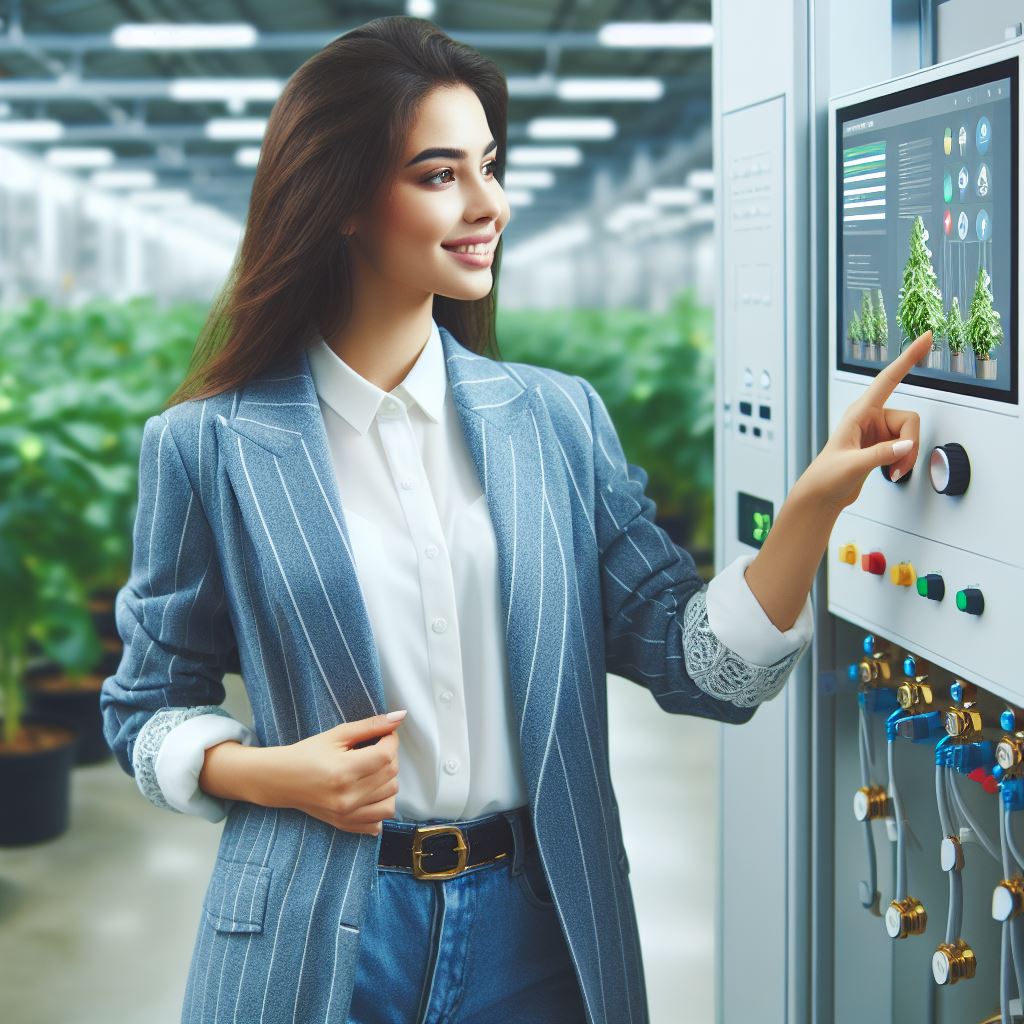Automated Watering Systems: A Game Changer
Last Updated on January 21, 2024
Introduction
Step into the future of efficient agriculture with automated watering systems, revolutionizing how we nurture crops and plants.
- Precision Irrigation: Explore technologies that deliver precise water amounts directly to plants, ensuring optimal hydration for growth.
- Time and Resource Efficiency: Say goodbye to manual watering as automated systems save time and reduce water wastage, promoting sustainability.
- Smart Sensors: Learn about sensors that assess soil moisture levels, enabling automated systems to respond to real-time plant needs.
- Climate Adaptability: Discover how these systems adapt to changing weather conditions, providing a tailored approach to watering in diverse environments.
- Integration with Farm Management: Explore seamless integration with farm management software, allowing for centralized control and efficient water resource allocation.
Automated watering systems represent a leap forward in agricultural technology, promising increased yields, reduced environmental impact, and sustainable farming practices.
Importance of Watering in Farming
In order to ensure optimal crop growth and plant health, proper watering is of paramount importance.
Let’s explore the crucial role watering plays in farming and the challenges faced in traditional manual watering methods.
The Crucial Role of Watering in Crop Growth and Plant Health
- Watering is essential in providing plants with the necessary hydration for their metabolic processes.
- It helps in the absorption of nutrients from the soil, facilitating their proper distribution within the plant.
- Optimal watering promotes cell division and elongation, leading to healthy plant growth and increased crop yield.
- Water acts as a solvent, aiding in the transportation of essential minerals and carbohydrates throughout the plant.
- Proper watering regulates plant temperature, preventing overheating and providing cooling during hot weather.
- It enables the maintenance of turgor pressure in plant cells, preventing wilting and ensuring firmness and structure.
- Without adequate watering, plants can suffer from drought stress, reducing their productivity and overall quality.
- Watering also plays a crucial role in regulating photosynthesis, the process by which plants convert sunlight into energy.
- Additionally, watering helps in the prevention of various plant diseases and pest infestations.
- Overall, proper watering is vital for maximizing agricultural productivity and ensuring the supply of nutritious food.
The Challenges Faced in Traditional Manual Watering Methods
- Traditional manual watering methods, such as sprinklers and hoses, are often inefficient and time-consuming.
- Water distribution can be irregular, leading to overwatering in some areas and underwatering in others.
- Manually watering large areas can be physically demanding and labor-intensive, requiring significant manpower.
- Inaccurate timing and frequency of watering can lead to plant stress, affecting growth and yield.
- Traditional methods do not consider the specific water requirements of different crops and plant varieties.
- There is a risk of water wastage due to evaporation, runoff, and inefficient use of available water resources.
- Manual watering cannot adapt to changing climate conditions and may not provide adequate moisture during droughts.
- The absence of automation in manual methods limits farmers’ productivity and hampers overall farm efficiency.
- Additional costs associated with manual labor, water usage, and maintenance of watering equipment can be considerable.
In general, watering plays a crucial role in crop growth and plant health, ensuring optimal productivity and quality.
However, traditional manual watering methods face several challenges that can negatively impact agricultural outcomes.
It is imperative to explore more efficient and automated solutions, such as automated watering systems, to overcome these obstacles and revolutionize farming practices for a sustainable future.
Read: Top 2024 Livestock Health Monitoring Gadgets
Overview of Automated Watering Systems
Definition of automated watering systems
Automated watering systems are advanced irrigation systems designed to efficiently water plants and lawns automatically without human intervention.
Explanation of how these systems work
These systems use a combination of sensors, timers, controllers, and valves to provide the right amount of water at the right time, based on the specific needs of the plants.
The key components of automated watering systems
- Sensors: Sensors detect environmental conditions such as soil moisture, temperature, and rainfall, allowing the system to adjust watering accordingly.
- Timers: Timers schedule watering events, ensuring that plants receive water at specific times and for specific durations, saving water and preventing overwatering.
- Controllers: Controllers act as the brain of the automated watering system, receiving inputs from sensors and timers, and activating the valves to release water.
- Valves: Valves control the flow of water, opening and closing to deliver water to different areas of the garden or lawn as programmed by the controller.
- Water Source: Automated watering systems are connected to a water source, which may be a municipal water supply, well, or rainwater harvesting system.
- Irrigation Zones: The garden or lawn is divided into irrigation zones based on plant types and water requirements, allowing targeted watering for optimal plant health.
- Drip Irrigation or Sprinklers: Automated watering systems can use drip irrigation, which delivers water directly to the plant’s root zone, or sprinklers, which distribute water over a larger area.
- Remote Control and Monitoring: Many automated watering systems are equipped with remote control and monitoring capabilities, allowing users to adjust settings and monitor water usage remotely.
- Water Conservation Features: Automated watering systems contribute to water conservation by adjusting watering schedules based on real-time weather data and soil moisture levels.
Ultimately, automated watering systems revolutionize the way we water our plants and lawns.
These advanced systems offer convenience, water efficiency, cost savings, and improved plant health.
With their key components and benefits, automated watering systems prove to be a game changer in gardening and irrigation practices.
Read: Innovative Manure Management Tools and Tips
Advantages of Automated Watering Systems
Increased efficiency and reduced labor
Automated watering systems eliminate the need for manual watering, saving time and effort for gardeners or farmers.
Automated systems use water efficiently, preventing excessive water usage and reducing the environmental impact associated with irrigation.
Consistent water supply and optimized water usage
These systems provide a consistent and reliable water supply, ensuring that plants receive the right amount of water at the right time, leading to healthier growth.
Automated systems apply water directly to the root zone, minimizing water evaporation and reducing overall water loss.
Automated systems distribute water evenly, minimizing water runoff and erosion, which can help preserve the health of the surrounding environment.
Improved plant health and crop yield
Automated watering systems deliver water directly to the roots, promoting optimal plant health and higher crop yields.
Although the initial investment may be higher, automated watering systems can lead to long-term cost savings by reducing water consumption and labor expenses.
Proper, consistent watering through an automated system can improve soil structure, leading to better nutrient and water retention capacity.
Reduced chances of over or under-watering
By using sensors and timers, these systems prevent over or under-watering, preventing water wastage and avoiding plant stress.
Automated systems allow users to program watering schedules based on specific plant requirements, ensuring each plant receives proper hydration.
Some automated systems can be controlled remotely, allowing users to monitor and adjust watering settings even when they are away from the garden or farm.
Automated watering systems deliver water directly to plants, reducing water availability for weed growth and minimizing weed infestation.
Essentially, automated watering systems offer numerous advantages including increased efficiency, consistent water supply, improved plant health, and reduced chances of over or under-watering.
These systems also contribute to water conservation, cost savings, and offer flexibility and convenience to users.
Embracing this technology can be a game-changer in achieving optimal plant growth and sustainable irrigation practices.
Read: Poultry Health: Preventing Common Diseases
Types of Automated Watering Systems
Automated watering systems have become a game changer in the field of gardening and agriculture.
These systems offer convenience and efficiency, ensuring plants receive the right amount of water at the right time.
There are several types of automated watering systems, each with its own unique features and benefits.
Drip irrigation systems
This type of system delivers water directly to the plant’s root zone, minimizing water waste and evaporation.
It consists of small tubes or hoses with emitters that drip water slowly and steadily to the plants.
Drip irrigation is suitable for gardens with a wide variety of plants, including shrubs, trees, and vegetable beds.
Sprinkler systems
Sprinkler systems are perhaps the most commonly used automated watering systems.
They work by spraying water through a network of pipes or hoses, covering a large area at once.
Sprinklers are ideal for lawns, flower beds, and larger garden areas.
Micro-irrigation systems
Micro-irrigation systems, also known as micro-sprinklers or micro-jet systems, distribute water through small spray heads or emitters.
These systems are suitable for watering smaller areas or specific plantings, such as containers or individual plants.
Micro-irrigation systems are highly efficient and minimize water runoff.
Smart irrigation systems
Smart irrigation systems utilize advanced technology to optimize water usage.
These systems monitor weather conditions, soil moisture levels, and plant water requirements.
By collecting and analyzing data, smart systems automatically adjust watering schedules to prevent over- or under-watering.
This results in significant water savings and healthier plants.
Now that we have explored the different types of automated watering systems, let’s discuss their advantages and why they are a game changer.
- Conservation of water: Automated watering systems ensure efficient water use by delivering water precisely where it is needed. Drip and micro-irrigation systems minimize water wastage due to evaporation or runoff.
- Time-saving: With automated systems, you can set specific watering schedules and forget about manually watering your plants. This saves time and effort, allowing you to focus on other gardening tasks or enjoy your free time.
- Improved plant health: By providing plants with consistent and targeted watering, automated systems promote healthier growth and development. Plants receive the right amount of water they need, reducing the risk of under or over-watering.
- Potential for remote control: Some automated watering systems can be controlled remotely through mobile apps or smart devices. This allows you to adjust watering settings even when you are away from home, ensuring your plants receive proper care at all times.
Lastly, automated watering systems are revolutionizing the way we water our plants.
From drip irrigation to smart systems, these technologies offer convenience, water conservation, and improved plant health.
Whether you have a small garden or a large agricultural field, an automated watering system can be a game changer for your gardening endeavors.
Read: Turkey Rearing 101: Basics for Beginners

Factors to Consider when Choosing an Automated Watering System
Automated watering systems have revolutionized the way we water our crops.
Gone are the days of manual watering, where farmers had to spend hours in the scorching heat, ensuring their crops received enough water.
With the advancement in technology, automated watering systems have emerged as a game changer in the agricultural industry.
When it comes to choosing an automated watering system, there are several factors that need to be considered.
These factors play a crucial role in determining the efficiency and effectiveness of the system.
Let’s take a look at six important factors to consider when choosing an automated watering system.
Crop type and water requirements
Different crops have different water requirements.
It is essential to select a watering system that can cater to the specific needs of your crops.
For example, some crops might require frequent watering, while others might need deep irrigation.
Field size and topography
The size and topography of your field will influence the type of watering system you choose.
If you have a large field, you might need a system that covers a wide area.
Similarly, if your field has uneven terrain, you might require a system that can navigate such obstacles.
Climate and environmental conditions
The climate and environmental conditions of your region play a crucial role in the watering system selection.
Some systems are better suited for arid regions, while others are designed for areas with high rainfall.
Consider the average temperature, humidity level, and rainfall patterns in your area before making a decision.
Budget considerations
Budget is an important factor when choosing an automated watering system.
These systems can vary widely in cost, depending on their features and capabilities.
It’s essential to set a budget and select a system that offers the best value for your investment.
Basically, selecting the right automated watering system requires careful consideration of various factors.
Understanding your crop’s water requirements, field size, climate conditions, and budget is crucial.
Additionally, ensure that the system is easy to maintain, compatible with your existing infrastructure, and offers room for future expansion.
By taking these factors into account, you can choose an automated watering system that will significantly improve your agricultural practices and yield better results.
Case Studies and Success Stories
Examples of successful implementation of automated watering systems
- Green Acres Farm in California installed an automated watering system, resulting in a 30% increase in crop yield.
- Jones Berry Farm in Oregon implemented an automated system, reducing water consumption by 40% while boosting strawberry production.
- Farmer Brown in Iowa witnessed improved efficiency and reduced labor costs after adopting an automated watering system for their cornfields.
The impact on crop yield and farmer’s profitability
- Automated watering systems ensure consistent and optimal moisture levels for crops, leading to increased yield and overall productivity.
- By avoiding water wastage and optimizing irrigation cycles, farmers can reduce operational costs and enhance profitability.
- Control over watering schedules and accurate distribution of water leads to healthier plants, improving the quality and market value of harvested crops.
- The ability to remotely monitor and control watering systems allows farmers to make informed decisions, maximizing crop yield and reducing losses.
- With automated systems, farmers can allocate their time and resources more efficiently, focusing on other aspects of farming and improving overall productivity.
The success of the Johnson Family Farm is just one example of how automated watering systems can revolutionize agriculture.
As technology continues to advance, more farmers can benefit from these systems, ensuring sustainable water usage, increased crop yield, and improved profitability.
It’s clear that automated watering systems are indeed a game changer in the agricultural industry.
Potential Challenges and Considerations
Initial cost and installation
While automated watering systems offer numerous benefits, there are also potential challenges and considerations to keep in mind.
Firstly, one hurdle that may arise is the initial cost and installation of the system.
These systems can be quite expensive, depending on the size and complexity of the setup.
Additionally, professional assistance might be required for the installation process, adding to the overall cost.
Maintenance requirements
Maintenance is another key consideration.
Automated watering systems need regular upkeep to ensure they continue functioning optimally.
This includes monitoring water levels, checking for any blockages or leaks, and cleaning and replacing filters as required.
Neglecting the maintenance can lead to malfunctions that can potentially damage plants and waste water.
Compatibility with existing infrastructure
Another crucial factor to consider is the compatibility of the automated watering system with the existing infrastructure.
It is necessary to evaluate if the system can seamlessly integrate with the current plumbing and irrigation setup.
In some cases, modifications or additional equipment may be necessary, which could add complexity and cost to the overall implementation.
Training and technical know-how required
Furthermore, users must have the appropriate training and technical know-how to use and troubleshoot the automated watering system.
Understanding how to program the system, adjust watering schedules, and address any technical issues is essential.
Without this expertise, users may struggle to take full advantage of the system’s capabilities.
A lack of training can also lead to inefficient water usage.
Users may unwittingly program the system improperly, resulting in overwatering or underwatering.
This not only affects plant health but can also waste water resources, negating the sustainability benefits of automated watering systems.
Generally, while automated watering systems can revolutionize watering practices, it is important to consider the potential challenges and requirements they entail.
The initial cost and installation, regular maintenance, compatibility issues, and the need for training and technical know-how should all be taken into account before adopting these systems.
With proper planning and understanding, these challenges can be addressed, allowing for efficient and sustainable use of water in gardening and agriculture.
Future Outlook of Automated Watering Systems
Emerging Technologies and Advancements
- Internet of Things (IoT) will play a crucial role in the future of automated watering systems.
- Sensors will become more advanced, allowing for real-time monitoring of soil moisture levels.
- Drones equipped with smart irrigation systems will revolutionize large-scale farming by providing precise and efficient watering.
- Artificial intelligence (AI) will be integrated into automated watering systems, enabling them to learn and optimize watering schedules.
Potential for Integration with Other Smart Agriculture Solutions
- Automated watering systems can be seamlessly integrated with smart weather monitoring systems to adjust watering schedules based on weather conditions.
- Integration with crop monitoring systems will enable automated watering systems to adapt to specific crop requirements.
- Smart irrigation systems can work in tandem with robotic agricultural machinery, creating a fully automated and efficient farming process.
Predicted Benefits and Market Growth Potential
- Increased water efficiency: Automated watering systems will reduce water wastage by delivering precise amounts of water only when necessary.
- Improved crop yields: By providing optimal watering conditions, these systems will enhance crop growth and yield.
- Cost savings: Farmers will save on labor costs as automated watering systems eliminate the need for manual watering.
- Environmental sustainability: These systems will contribute to sustainable farming practices by conserving water resources.
- Market growth potential: With the increasing demand for efficient agriculture practices, the market for automated watering systems is projected to experience significant growth.
Overall, the future outlook for automated watering systems is promising.
Emerging technologies and advancements, such as IoT, advanced sensors, drones, and AI, will revolutionize the way agriculture is practiced.
The potential for integration with other smart agriculture solutions further enhances the benefits of these systems.
Through water efficiency, improved crop yields, cost savings, and environmental sustainability, it will play a crucial role in shaping the future of agriculture.
With a predicted increase in market growth, investing in automated watering systems is a wise choice for farmers looking to optimize their irrigation practices.
Conclusion
- Efficiency Unleashed: Automated watering systems prove indispensable in optimizing water usage for agriculture.
- Sustainable Farming Practices: The adoption of such systems aligns with global efforts toward sustainable and responsible farming.
- Technological Evolution: Embracing automated solutions signifies the agricultural sector’s integration of cutting-edge technology for enhanced productivity.
- Economic Viability: Beyond initial investments, the long-term economic benefits, resource savings, and increased yields underscore the financial viability.
- Environmental Stewardship: By minimizing water wastage, these systems play a crucial role in promoting environmental conservation and responsible water management.
All in all, automated watering systems mark a transformative leap in agriculture, offering efficiency, sustainability, and technological advancement.
This paradigm shift reflects a commitment to both economic prosperity and environmental responsibility in the agricultural landscape.


